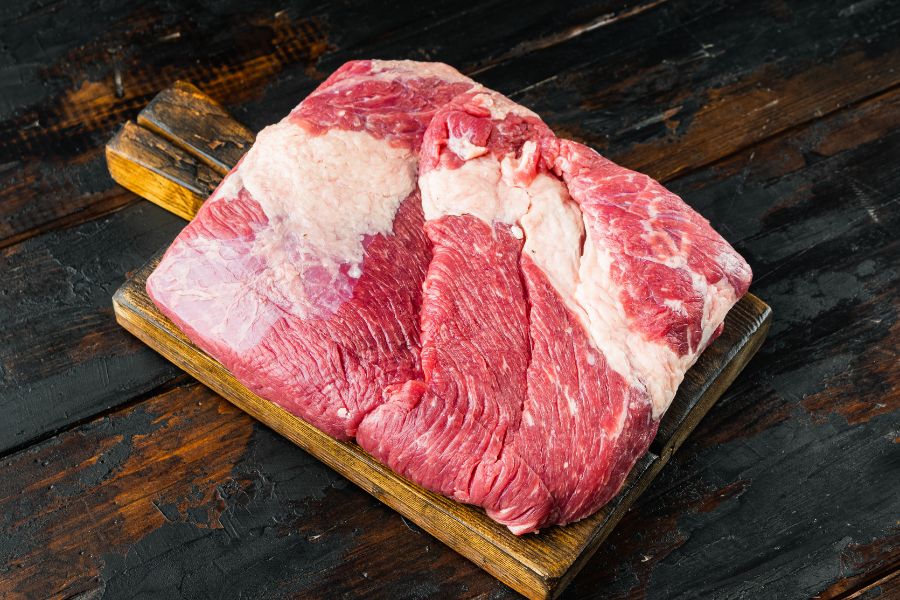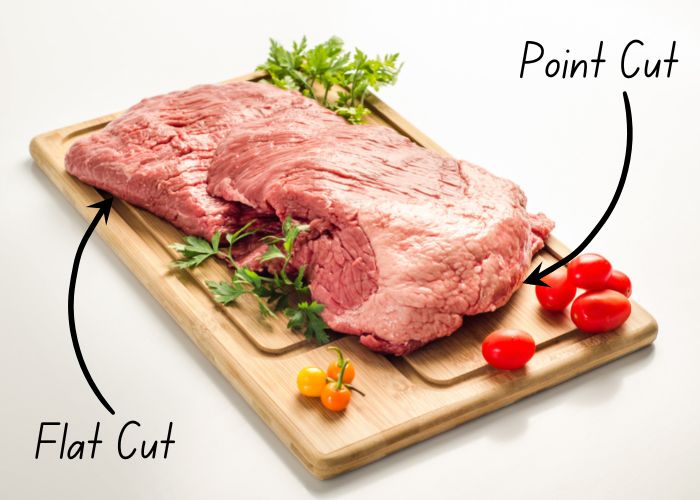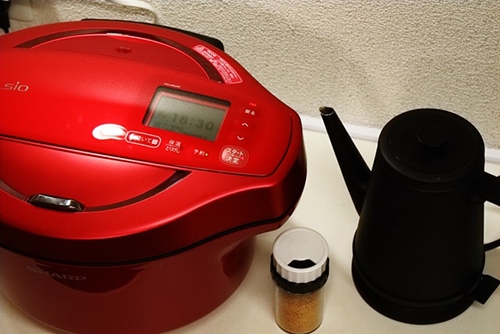The top differences include size, flavor, fat content, and more!
I had to learn about the intricate variations of brisket flat vs. point in culinary school and it was eye opening. I am now here to pass on my knowledge to you!
In this post I will outline the main variations, talk to you about how to cook a brisket, and a whole lot more!

Before I go into the differences between brisket flat and point cut, I first want to talk about what a beef brisket actually is. A lot of people tend to get confused about this term because it can refer to both the cut as well as the dish.
Related Reading

So, let’s first get this sorted out for you:
A whole brisket is the meat that is taken from the breast or chest section, below the first five ribs, and underneath the foreshank. This chest muscle group works a great deal to support the weight of the cow.
As a result, this cut of meat is large – around 3 to 8lbs per section. It is also made up of tough connective tissue. It is the reason that brisket is so affordable – it needs to be cooked properly before it is tender enough to eat.
Related Reading
Now, the above section is often referred to as a whole packer brisket. As mentioned, it is a large section of meat and it is made up of two muscles. In most instances, these muscles are separated and sold as two sections – brisket flat and brisket point.
The first cut is known as the brisket flat cut but may also be referred to as the beef brisket middle cut, brisket center cut or the thin cut. It is the leaner of the two sections.
The second cut is known as the brisket point cut. This has a thick layer of fat on it which makes it the far more flavorful option. It is sometimes known as the deckle.

Related Reading
Here is an in-depth explanation on how to tell these two cuts apart:
One of the first things that you will notice is that the brisket flat is larger. True to its name, it is also more uniform in shape and lays flat for the most part.
This is unlike the brisket point which has a thicker and thinner end. As such, it can be a little trickier to cook evenly at the same time.
Related Reading
As mentioned, the brisket point has more marbling on it. It has a layer of fat that is known as the fat cap. One of the benefits of this is that the fat helps to keep the meat moist as it is cooked.
However, this extra fat content isn’t always viewed as a good thing. This is because the point doesn’t have as nearly as much meat as the flat and isn’t as much of a meal.
The point cut has a more intense beef flavor than the flat. This is because fat equals flavor and point has an extra fat layer, unlike the flat. Thus, the brisket point doesn’t need as much seasoning.
This doesn’t mean that you can’t salvage the cut, though. With the right spices, you can give it more flavor. Of course, this doesn’t really compare to the beefier flavor of the point.
As the flat and the point have so many variances in terms of flavor and texture makes it only natural for them to be used in different ways too.
As the cut has more lean meat on it, it is typically subjected to braising. Thus, it can be added to sandwiches, served as a main, or as a side.
The brisket point is most commonly known for being the key ingredient for corned beef. It can also be used as hamburger meat.
Related Reading
Although the brisket point tends to produce more tasty results, flat is the mor popular cut. This has to do with the fact that it has more meat and offers more bang for the buck.
You are more likely to find brisket being sold as a whole brisket or with the flat. It is unusual for the deckle to be sold separately.
One of the differences between flat and the point cut is the cooking time. In general, the brisket flat will cook faster than the brisket point.
This is because the the flat cut has a higher fat content than the brisket point. And, when you compare fat and connective tissue, fat melts more easily. It can take longer for the connective tissue to break down so that it is tender enough to enjoy.
Related Reading
Now, I can’t mention all the variations between the point and the flat without also mentioning a similarity.
They both need to be prepared with the low and slow method. This is why you will often find them being braised, smoked, or put in a slow cooker.
This is because they both consist of tough meat that has to be cooked for several hours at a time before it is truly edible.
Related Reading
The secret to a good brisket is high quality meat. This is why you should always go to a good butcher shop to buy either cut.
If you have to make the choice yourself, then pay close attention. When it comes to the flat, you want a nice and uniform shape with a small amount of fat. Remember, uneven areas will lead to uneven cooking.
As for the point, you want a decent amount of fat cap, but not too much marbling. Keep in mind that you have to trim off excess fat. So, if there is too much fat at the butchers, you are simply paying extra for sections that you will have to get rid of later.
Related Reading
As mentioned, there are three ways of cooking brisket. Here is a breakdown of each cooking process:
Flat cut makes for the best section here. This is because plenty of liquid is added into the mix. This ensures that the meat will turn out moist and tender.
The first step involves browning the meat. Do this on high heat, on your stovetop. Once the flat has gained color, place the meat into a large pot. Add a flavorful liquid – canned tomatoes, broth, or even wine will do. Then, cook the brisket on low or up to three to four hours.
Once it is done, you can shred the meat. Use the shredded meat in sandwiches, much like you would use pulled pork.
This technique is quite similar to braising, extended cooking time and all. The main difference is that a slow cooker doesn’t require as much of your attention. Simply punch in the settings and you are good to go.

Once again, you have to start by browning the meat. This time, though, you can do it in the slow cooker. The next step involves placing the brisket fat side up and adding either a braising liquid like before or a marinade – barbecue sauce is a great choice.
You can also season the meat with various spices. Then, set it to low heat – the lowest setting available and cook as needed.
If you are planning on smoking a full packer brisket, then it is known as a Texas style brisket. You can also choose to smoke either the flat or the point.
Start by liberally apply a rub to every inch of the meat. Then, preheat the smoker – set to a low temperature – 225 to 250 degrees Fahrenhit is a good point.
Place the meat in the smoker and allow to cook until done. This should take around an hour or hour and a half per pound of brisket.
However, you should wait until the internal temp of the meat has reached 180 to 185 degrees. You can use a meat thermometer to check the temperature.
Allow it to rest for an hour or so before slicing and serving.
Related Reading
Many people are curious about whether or not you should separate a whole packer brisket. Does it make sense to split these sections up?
Well, as stated, it is quite common for these two segments to be sold together as a whole packer. Even if the sections are separated, the flat is most likely to be sold on its own.
At the same time, these two cuts do cook quite differently. They also vary in how they present. Therefore, it makes sense to separate them before cooking if you are looking for varying results. This ensures that each part is cooked to perfection in its own way.
One of the top reasons that people – even pitmasters – split up brisket, though, is size and time. A full brisket can take up to half a day to cook. If you don’t want to have to wait for so long or being timed in a competition, then it makes sense to cut brisket into two sections.
Here is a step by step guide to separating the two sections:
Use a boning knife for this process. Start by placing the packer brisket fat side down on a cutting board. When you do this, the brisket flat half is exposed to you. You will now see a visible layer of fat – this is known as the brisket nose cut.
It is the fat layer that segregates the flat from the point.
To avoid making any mistakes, you may want to cut scoring marks into the nose. This can act as a visual guide for you.
Once you are done, cut downwards into the fatty layer. As you follow the nose, you will notice that it curves under the flat. As you cut this area, it is best to lift up the flat with a hand. It is best to avoid cutting into the flat.
As you continue, you will reach the end of the point. Once you reach the thinnest section, slice through it. The two sections will be completely separated.
Then, it is just a matter of timming off exterior fat from the point and they are both good to be used!
Related Reading
There you have it – the main variations between flat and the point. Who could imagine that joined meat could be so different from another? Now that you are armed with this information, you can choose the best cut for you.